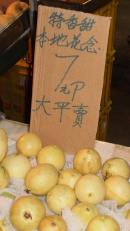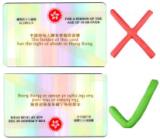A weekend visit reveals good news for customers of goods and services in Macau from, surprisingly, the public sector. Hong Kong ID card holders entering and exiting Sleaze City may now use their very own, specially reserved electronic immigration channels of the high-tech sort they already use going in and out of the Big Lychee.
Needless to say, officials have taken every effort to complicate things:
- You need to authorize the transfer of personal details, fingerprints and photo from the Hong Kong Immigration Department to their Macau counterparts. You can do this on automated screens after you go through Hong Kong immigration at the ferry terminal. You put your ID card in, get both thumbs scanned twice, press various buttons on the screen, then get a little printout, which serves no real purpose.
- This transfer takes five working days. So when you get to Macau on this trip (assuming that’s where you’re going), you still have to line up behind time-wasting dawdlers to show your card to a lethargic human in a uniform.
- After the five working days have passed, you can use the Hong Kong
 residents’ e-channels to get into Macau. Unlike our nice, sensible, user-friendly machines, where you stick the ID card into an ATM-style slot, Macau’s require you to slide the card face-down along a ridge onto a glass screen for scanning. Howls of anguish from first-time users filled the immigration hall this weekend as Hongkongers’ cards failed to activate the system and open the little doors. The trick – people eventually find – is to slide it across upside down. (I have devised a rather nifty mnemonic to help people remember this: Mibac, ‘Macau Immigration Bosses Are Cretins’.) The machine issues a disposable slip of paper confirming the right to stay for (in my case) a generous 12 months.
residents’ e-channels to get into Macau. Unlike our nice, sensible, user-friendly machines, where you stick the ID card into an ATM-style slot, Macau’s require you to slide the card face-down along a ridge onto a glass screen for scanning. Howls of anguish from first-time users filled the immigration hall this weekend as Hongkongers’ cards failed to activate the system and open the little doors. The trick – people eventually find – is to slide it across upside down. (I have devised a rather nifty mnemonic to help people remember this: Mibac, ‘Macau Immigration Bosses Are Cretins’.) The machine issues a disposable slip of paper confirming the right to stay for (in my case) a generous 12 months.
Despite these irritations, the new procedure is a godsend. Breezing through on the way out is especially welcome, and made all the more enjoyable because you do it in full view of the lengthy lines of Mainland and foreign tourists, clutching their passports and landing cards, and seething with jealousy and resentment.
The bad news for consumers in the plucky little ex-Portuguese enclave is that vendors in the street markets in the Three Candles neighbourhood – their version of Mongkok, basically – have reacted to rising food prices through a type of subterfuge that leaves some shoppers feeling cheated.
At some stage in the past, the fruit and vegetable sellers would have offered their wares by the catty, the traditional measurement equivalent to 600 grams or 1.3 pounds. Years ago – possibly during an earlier period of price rises – they went metric and started to sell by the half-kilo, ie, 500 grams or 1.1 pounds. No prizes for guessing what comes next.
 They now sell by the pound, or 450 grams. The English measurement is not unknown in Macau; probably because of the long relationship with the old British colony across the Pearl River Delta, some grocery outlets use it. But it is new in the street markets, where it is signified by the letter ‘p’ (for pang – as with the succulent pears on the left) rather than ‘lb’.
They now sell by the pound, or 450 grams. The English measurement is not unknown in Macau; probably because of the long relationship with the old British colony across the Pearl River Delta, some grocery outlets use it. But it is new in the street markets, where it is signified by the letter ‘p’ (for pang – as with the succulent pears on the left) rather than ‘lb’.
(‘Lb’, as we all know, comes from the Latin libra, or weight. The Romans occupied the Iberian peninsula by 150BC, so it is likely that Portuguese were using the pound 200 years before the British did; therefore, you could make a tortuous case for the unit being a part of Macau’s colonial heritage, though I don’t think I would bother.)
The next step for the Three Candles stall holders will, of course, be to start selling things by the half-catty.


I did it the other week and was able to use the e-channel straightaway, but didn’t use an auto machine, actually queued up and spoke to a person, had thumbs scanned and photo taken.